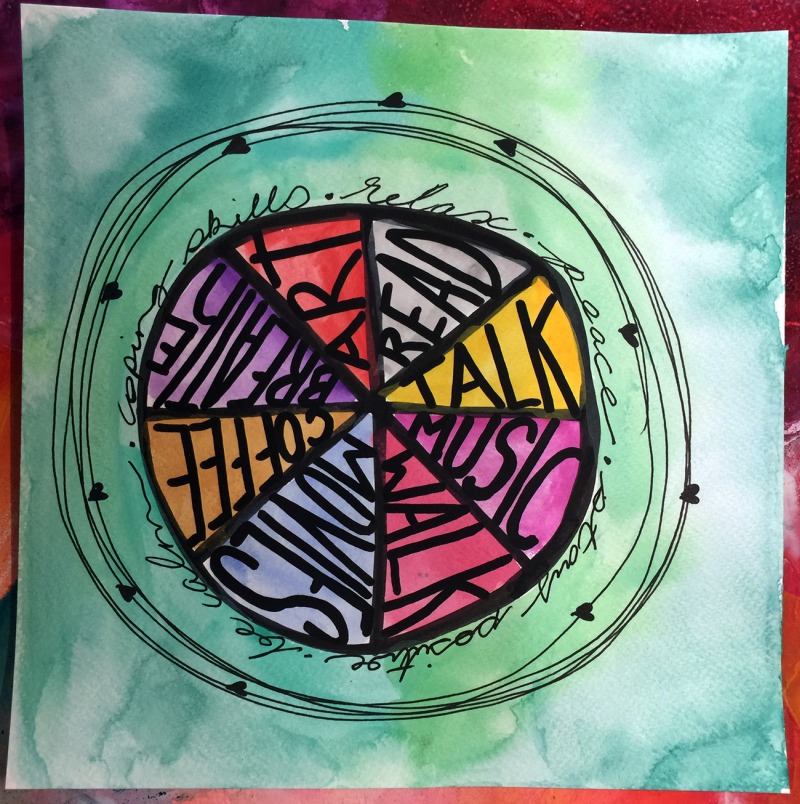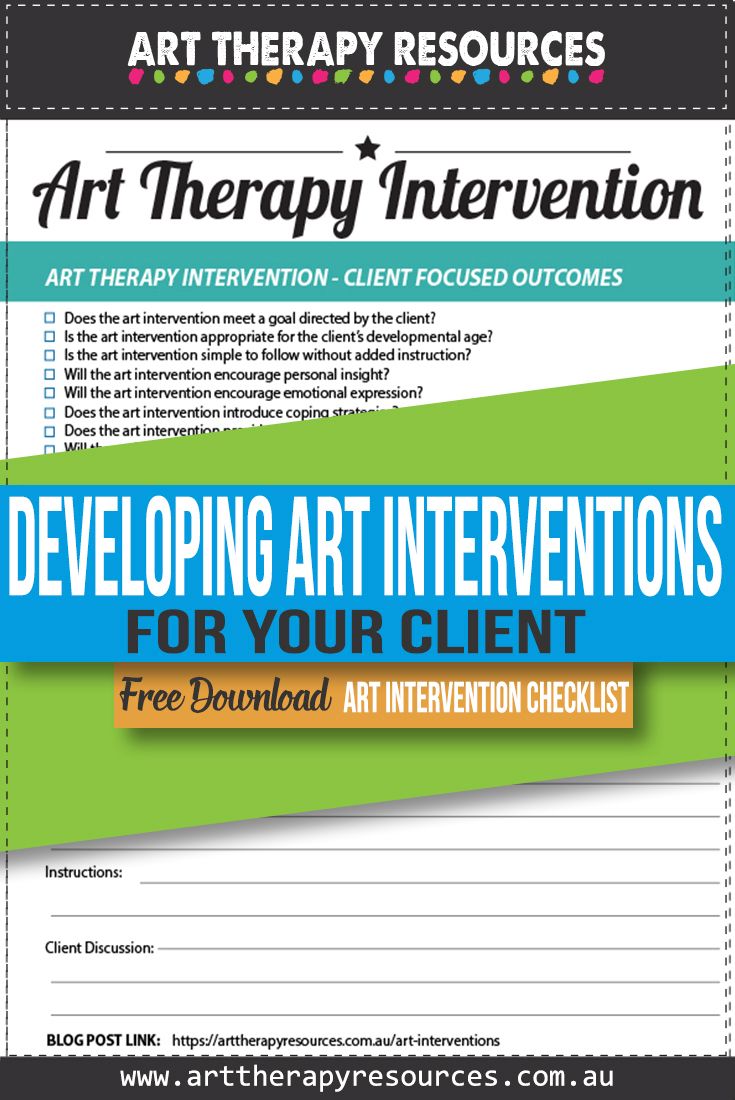THIS POST INCLUDES:
1. Why Develop Art Therapy Interventions
2. Understanding your Client’s Needs
3. Creating an Art Therapy Intervention
4. Free Download Art Intervention Checklist
WHY DEVELOP ART THERAPY INTERVENTIONS
An art therapy intervention refers to a technique used within an art therapy session to facilitate the creative process for the client to explore and gain insight into their experiences. Art interventions can often be written as methodical, however, all therapists understand that working with clients often requires adapting previously used techniques to respond to the client’s exact needs at that time.
Despite the need for flexibility, there is a benefit for therapists to have a collection of therapeutic interventions in their therapy ‘bag’ for use with clients. While each client brings with them a lifetime of individual and unique experiences, they can also present with common threads amongst these experiences. Using generalised art therapy interventions is also relevant to group work where the entire group follows a specific structure.
The art therapy community has many textbooks that provide insightful art interventions that therapists can use with clients. In addition to using previously created art therapy interventions, you may want to create your own, yet you may feel unsure if there is a specific protocol to follow when creating your creative interventions.
If you have a client demographic with common presenting problems you may want to develop a set of interventions that you can refer to based on their success with other clients who meet the demographic. As an art therapist, you may want to develop your workshop or art therapy program that introduces art therapy interventions as practical parts of your workshop. These situations present you with an opportunity to develop your art therapy interventions.
It’s important to remember that art therapy interventions are not about creating prescriptive art exercises that clients must follow. Instead, art therapy interventions can provide direction and a framework that can help provide a safe mechanism for clients who appreciate a framework or guidelines for exploring difficult emotions.
Developing an art therapy intervention can be developed by following how protocols are developed under a scientific model.
Developing a protocol usually follows the below stages:
- Get an idea for treatment
- Notice a pattern
- Develop a protocol
- Test the protocol
- Document the results
- Analyse the results
- Adapt the protocol where necessary
- Develop related protocols
UNDERSTANDING YOUR CLIENT’S NEEDS
Variables are an integral part of any evidence-based treatment. For therapists, it becomes obvious over time that clients who present with a history that seems to fit a specific understanding of a psychological experience often have unique variables that make therapy unscripted. This is the primary benefit of psychotherapy that pursues the individual’s unique story.
A client’s needs can depend on two primary factors:
- Psychological – including personality, emotional and developmental needs
- Physical – including physical abilities and physical development needs
It’s important to understand the client’s needs based on these two primary factors when developing an art intervention for a client or clients in an art therapy group.
On a practical basis, there are many factors to consider in an art therapy session about the physical nature of undertaking art activities. These factors include:
- The time allocated to an individual session vs the time it takes for art supplies to dry
- The suitability of art supplies for specific projects. For example, if an art project is large in size, the therapist should provide art supplies that allow large coverage instead of supplies that are primarily used on smaller projects.
- The sensory nature of art supplies. Some art supplies may feel dry and chalky while others may feel slimy. These sensations may trigger an intense sensory experience for the client
CREATING AN ART INTERVENTION
The initial stage of developing an idea for an art therapy intervention can stem from previously developed art therapy interventions that have historically been used in the field of art therapy. This process is similar to the research process where research builds upon research as a method of improving treatment and our understanding of the knowledge of art therapy.
This idea can also stem from other psychological interventions outside of art therapy, including CBT, DBT or psychodynamic focused approaches.
To read more about different counseling approaches, check out our previous blog post: Effective Counselling Approaches Used in Art Therapy
As mentioned before, it is helpful to develop a set of steps that is based on the general stages involved in creating scientific protocols. From the previously mentioned list, you can develop your own set of criteria that will help you formulate a process for developing an art therapy intervention.
The scientific protocol stages include:
- Get an idea for treatment
- Notice a pattern
- Develop a protocol
- Test the protocol
- Document the results
- Analyse the results
- Adapt the protocol where necessary
- Develop related protocols
You may also want to incorporate the overall guidelines of:
- individual client experiences
- building upon previous art therapy interventions
- using other psychological interventions outside of art therapy
You may create an art therapy intervention structure that looks like below:
- Historical art therapy intervention reference: reference any original art therapy interventions that might have inspired your intervention
- Psychological treatment reference: reference any therapeutic treatments outside of art therapy that has inspired your intervention
- Type of creative therapy: note the type of creative therapy you are using and any supplies required (eg, art therapy, music, dance etc)
- Suitable for clients experiencing: note the psychological experiences that clients may have that will benefit from this intervention (eg. anxiety, depression etc)
- Suitable for client demographics: is this art therapy intervention relevant to all clients or only specific age, genders, cultures etc
- Proposed art therapy intervention: what is your proposed art therapy intervention that factors in all of the above information
- Testing process: document how you will test your proposed art therapy intervention. Seek feedback from clients and colleagues.
- Analyse the results: document how you will analyze the art therapy intervention
- Revised art therapy intervention: what is your revised art therapy intervention based on the testing and assessment
- Document final art therapy intervention: document your final art therapy intervention so that others can follow your process
Remember, the above is a guideline for creating your art therapy intervention and not all fields have to form part of your development process.
In addition to the above formal process of developing an art therapy intervention, you may want to consider some ancillary questions that are primarily focused on the client’s experience, such as:
ART THERAPY INTERVENTION – CLIENT FOCUSED OUTCOMES
- Does the art intervention meet a goal-directed by the client?
- Is the art intervention appropriate for the client’s developmental age?
- Is the art intervention simple to follow without added instruction?
- Will the art intervention encourage personal insight?
- Will the art intervention encourage emotional expression?
- Does the art intervention introduce coping strategies?
- Does the art intervention provide emotional regulation?
- Will the art intervention help understand emotions, thoughts, and behaviours?
- Does the art intervention encourage problem solving skills?
- Does the art intervention provide a positive framework for the client?
- Is the art intervention practical?
- Can the art intervention be replicated?
- Does the art intervention focus on the client?
Not all questions above will relate to your art therapy intervention, however, the above questions will help guide you through developing a client focused art therapy intervention.
Once you have developed your art therapy intervention is developed, you can create a simple template to record the procedural parts of your art therapy intervention.
This can be kept very simple as shown in the example below:
ART THERAPY INTERVENTION PROCEDURE:
- Art therapy intervention title:
- Suggested art materials:
- Instructions:
- Client Discussion:
An example is included below:
- Title: Relaxation Technique Pie
- Art Materials: Drawing paper, markers, pens, pencils, crayons, collage
- Instructions: This exercise involves your client finding positive activities to engage in to reduce the impact of negative events in life. Your client should feel empowered that they have a range of coping skills to help alleviate anxiety and stress and consequently reduce the anxious feelings they experience. Identifying and labeling effective strategies helps your client rely less on reactive behaviour, and instead employ positive steps to successfully navigate through stressful situations.
- Discuss with your client the type of art supplies they may like to work with in this session. This exercise involves constructing a collage of your client’s favourite things or activities that helps diffuse stressful situations and relationship conflicts. As this exercise involves constructing a collection of images your client may wish to use collage techniques and collect images from magazines or free clip art from online sources (eg. http://www.freepik.com/). Alternatively, your client can use their drawing skills or create a collage based on powerful words. These words can also be cut out from other sources or hand drawn.
- Once your client has collected their art supplies and image sources, they can begin to construct their collage of images that represent relieving anxious feelings. This exercise will help your client understand how managing stress regularly can improve overall emotional stability.
- After your client has completed the art therapy exercise, you can discuss their choices of images and words that they believe will help manage stress in daily living. Discussion can focus on when to engage in these activities so that your client can feel empowered to be able to navigate through potential stressful events in the future.
- Discussion/Goals: Discussion may focus on risk taking and control issues. The theme of perfection (who needs to be perfect and who can allow themselves to be imperfect) often emerges from this warm-up. This experience allows clients to “loosen up” and freely express themselves.
Client Discussion: The client created a pie chart of activities they could engage in as relaxation techniques to cope with their anxious feelings. These activities could be used as a part of the client’s daily life. They could also be used when dealing with conflict and situations where anxiety levels increase.
The artwork can be kept as one piece of it could be cut up into individual pieces of pie known as coping cards. These coping cards can be used by the client when they want to spontaneously engage in a stress reducing activity.

FURTHER READING:
If you would like to read additional information on an example of developing art therapy interventions, the following journal article may provide some additional insight into this process:
FREE DOWNLOAD: Art Therapy Intervention Checklist
SIGN UP below to download the FREE Art Therapy Intervention Checklist to provide a guideline for developing a client focused art therapy intervention.
A suggested art therapy intervention procedure template is also included.

BUILD YOUR ART THERAPY REFERENCE MATERIALS:
Pin this image to your Pinterest board.

SHARE KNOWLEDGE & PASS IT ON:
If you’ve enjoyed this post, please share it on Facebook, Twitter, Pinterest. Thank you!
